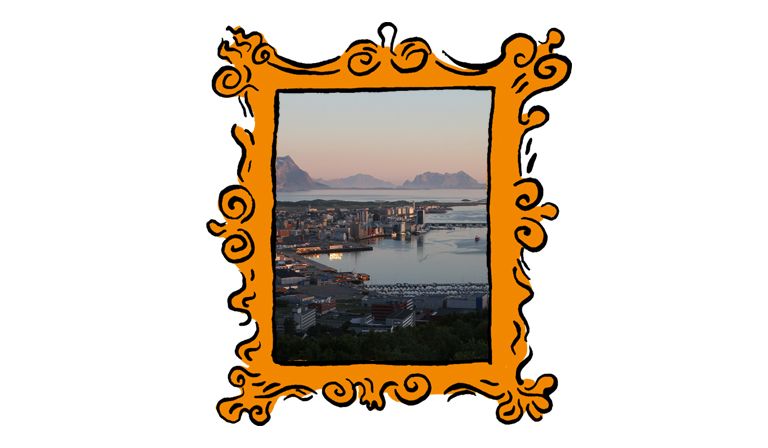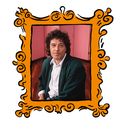Queen Sonja of Norway potters about, observed hawkishly by three sharp-suited men that could’ve come straight out of The Matrix. Resembling any affluent matriarch of a certain age in, say, London’s leafy St John’s Wood, she inspects a rusted shipping container containing colourful art—including some of her own. The container is situated in the Arctic Circle town of Bodø (pronounced “Bo-duh”). Nearby, a few individuals sun themselves in desultory fashion under mild summer Arctic sun. I’m the only person taking pictures of this royal visit. If there must be a monarchy, it should be this way: low-key and chilled, much like the Norwegian temperament.
Queen Sonja is the founder and patron of a slew of biannual awards for fine art printmaking. This year’s main prize went to Sámi artist Tomas Colbengtson; the Lifetime Achievement Award to Anselm Kiefer; and the Inspirational Award to Maria Kayo Mpoyi. Colbengston has described his own art as having a “politically charged aura”, and the same could equally be said of Mpoyi, as both investigate the impact of colonial legacies through their work. (Maria Kayo Mpoyi was born in the Democratic Republic of Congo but now lives in Sweden.) Mpoyi later added: “I make art to develop tools for healing, change, movement. Colonialism affects the whole of humanity.” The British historian Simon Schama, speaking at Bodø’s Barbican-esque Stormen Konserthus on Anselm Kiefer’s own massively politically charged works, described the medium of prints as possessing “the capacity to represent immense acts with startling economy and technique”.
The awards coincide with Bodø’s year-long mantle as European Capital of Culture for 2024, representing Norway’s largest cultural project in 10 years and the first-ever European Capital of Culture this far north of the Arctic Circle (albeit as Norway’s third city to take the title). Begun in 1985 as an arts festival by then Greek minister of culture Melina Mercouri, today it is one of Europe’s most high-stake cultural initiatives, connected to valuable social and economic objectives. With the recent European Union elections resulting in big wins for the far-right, the title’s emphasis on culture, diversity and collaboration is surely more welcome than ever. Nowadays, usually three cities are given the title simultaneously; Bodø shares it this year with Bad Ischl in Austria and Tartu in Estonia.
Once Norway’s most significant air base during the Cold War, now Bodø is in a period of transition: the fighter planes have moved out, leaving culture free to move in. With a programme stretching across the county of Nordland, 800km from north to south, every one of the 1,000 culture capital events being held here are linked in some way to Arctic nature, the north’s connection to European heritage and to future international development in the region.
As I mooch along the harbour, the sunlight seems scrubbed and super-charged. I visit a not-for-profit sauna collective, offering sessions for 125 kroner (about £9). By the post-sauna jump-off point, cold, clear waters reveal a fleet of tiny fish, starfish, seals and purple jellyfish among lush hanks of seaweed, whose colours, lengths and textures are indicative of this landscape’s wild bones. The absence of light in winter is, at least, democratic. I discover that both the town’s mayor, Odd Emil Ingebrigtsen, and my taxi driver, a man named Trond, are each taking their spouses to the Gran Canaria in January on one of the two flights a week that leave from Bodø. “People suffer from depression with the lack of light,” Trond told me. “Although I wouldn’t live anywhere else.” While Bodø is no Arctic-outpost with wandering polar bears (the city is an hour away from Oslo by plane), if you are Arctic-inclined, this, with its dazzle of mountains and midnight sun, is where things start to get interesting.
Bodø’s problem is that its young are leaving, mainly to Oslo, and not returning, says Marie Peyre, international communications and relations manager for Bodø2024 (and originally from Marseille). Can a healthy injection of cultural currency provide enough “legacy” projects to entice Bodø’s young to stay? Can Bodø become a destination in its own right rather than obvious jumping-off point to the nearby “wow” destination of the Lofoten archipelago? (The islands are on National Geographic’s list of the 30 most exciting places to visit this year, and will soon levy a hefty tourism tax.) With a build-it-and-they-will-come philosophy, Bodø’s new airport is intended to be operational by 2029, with the current one’s land being cleared for residential use. During one meeting, the mayor Ingebrigtsen (a member of the Norwegian Conservative party) conveyed his enthusiasm for Bodø to become a future tech hub, while admitting that fishing is a “dying industry”.
Change—slightly—is also in the air regarding Norway’s indigenous Sámi people. Bodø2024’s three themes are Nature, Fish & Ships and Transition. Highlighting Sámi artists is an unofficial fourth theme, with arts from all regions of “Sápmi”—the homelands of the Sámi people, spanning the northern areas of Sweden, Finland, Russia and Norway—taking centre stage. This is all especially pertinent for Bodø, spanning as it does the territories of the Lule Sámi and the Pite Sámi, each of whom call the city Bådåddjo and Buvvda.
Although there was some online criticism following the print awards’ two-hour opening ceremony, mainly due to its foregrounding of Sámi people—among them the singer Ella Marie Hætta Isaksen, who wore a jacket with the words “This is Sámi Land”—support for Sámi rights in Norway is rising. This is helped by the country’s own Truth and Reconciliation Commission which seeks to acknowledge and address the effects of historical “Norwegianisation” policies on the Sámi, who the government now recognise as a national indigenous group. “We younger ones accept and celebrate Sami culture,” as Andrea, manager of the sauna collective by the harbour, told me. “It’s the older generation who are the problem.”
Art in a very cold climate
Bodø, north of the Arctic Circle in Norway, is the European Capital of Culture for 2024. It is a place of cultural pride and problems
June 13, 2024

© Gerd Eichmann / Wikimedia Commons








